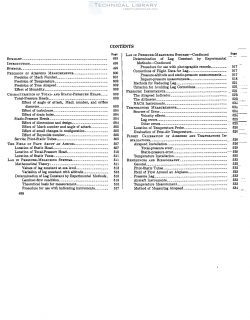naca-report-919

- Version
- 222 Downloads
- 3.80 MB File Size
- 1 File Count
- August 31, 2016 Create Date
- August 31, 2016 Last Updated
National Advisory Committee for Aeronautics, Report - Accuracy of Airspeed Measurements and Flight Calibration Procedures

The sources of error that may enter into the measurement of
airspeed by pitot—static methods are reviewed in detail together
with methods of flight calibration of airspeed installations.
Special attention is given to the problem of accurate measure-
ments of airspeed under conditions of high speed and maneu-
verability required of military airplanes.
The accuracy of airspeed measurement is discussed as limited
by errors in each of the quantities that is directly measured in
jlight. Existing data on the errors at the total— and static-
pressure openings associated with the geometry of pitot-static
tubes are summarized, followed by charts and a qualitative
description of the errors caused by operation within the pressure
field of the airfoil. The errors introduced at the measuring end
of the system due to lag in pressure transmission are reviewed
and some new material on this subject is included along with
methods and charts for making appropriate lag corrections to
airspeed measurements.
A brief discussion is given of the magnitude and type of error
introduced by the mechanical and elastic characteristics of the
conventional airspeed indicator and altimeter. Similar material
is given for typical NAOA pressure-recording instruments.
Since knowledge of true airspeed is dependent upon a tempera-
ture measurement, existing material on the accuracy with
which temperature can be measured with various types of probes
is summarized and discussed. hfethods used by the National
Advisory Committee for Aeronautics in flight calibrations of
airspeed and temperature installations are outlined.
The present report has been arranged in such a way that each
section may be read independently of the others. An attempt
has been made to consider all factors that limit the accuracy
with which airspeed may be determined by the usual pitot-
static methods.
| File | Action |
|---|---|
| naca-report-919 Accuracy of Airspeed Measurements and Flight Calibration Procedures.pdf | Download |

Comment On This Post